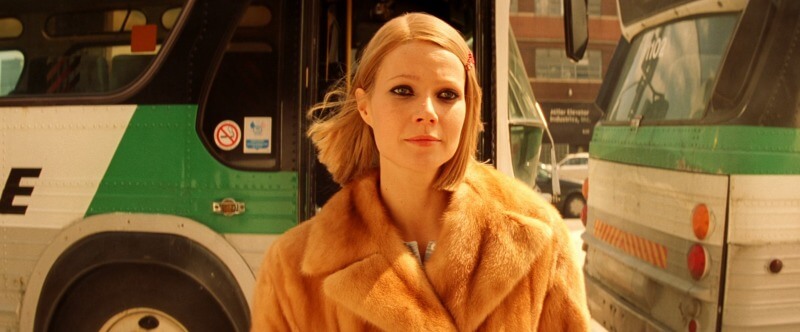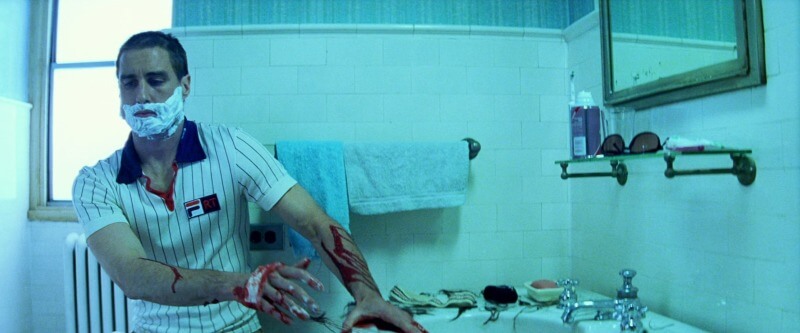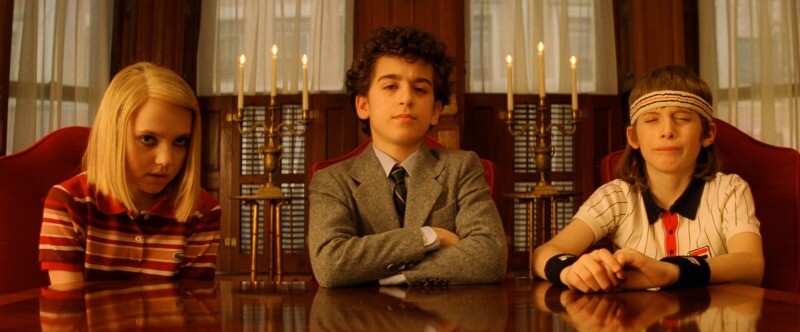Color Theory: Wes Anderson and the Comforting Warmth of The Royal Tenenbaums

Wes Anderson, King of Color, kicked down the door to his career when he released The Royal Tenenbaums in 2001. Bottle Rocket and Rushmore were escalating degrees of indie breakouts, but his star-studded, enigmatic third more than tripled the combined box office of the previous two (The Grand Budapest Hotel is still the only one that’s bested it). More importantly though, on the artistic front, it established the sprawling, playful, varicolored imagination that we now associate with his work.
On the heels of his newest, The Phoenician Scheme, nearly a quarter-century later, Tenenbaums is still among his best work, a film supremely indicative of the contagious creativity, singular artistic taste, and pure passion – or “single-track mind,” as he puts it – that have come to define Anderson’s 13-feature filmography. Spotlighting specific frames, we look back at The Royal Tenenbaums with a focus on the myriad, masterful ways Anderson uses color to tell stories, enliven characters, set tones, create moods, evoke themes, and, ultimately, immerse us in his world.

Of all the exceptional trademark needle drops and slow-motion sequences across Anderson’s career, the moment adult Richie (Luke Wilson) finally sees Margot (Gwyneth Paltrow), his step-sister and the love of his life, remains the most poignant. Anderson slows down time as he launches into the Nico-drenched scene, a fuzzy, dreamy quality emerging from the washed out electric guitar plucking and strange fairytale vocals. The sun sends light and casts shadow across the three shades of Margot’s golden blonde exterior – her hair, her skin, and her fur coat – which is dotted with the romantic blush tones of her lips and hair clip.
Outside her person, the red-orange jewel tones on the stickers and lights of the buses surrounding her are like sparks bursting beneath the surface between the two. The shot will flash again when Richie is cutting his wrists later, his lost love passing before his eyes – a perfect encapsulation of feeling, of how intoxicated he is by her presence. The Green Line she arrived on seconds prior to the slow-down ushers a striking presence into frame via kelly green color strips, just as it delivers the striking presence of Margot to Richie.

Backing out to a wide shot, we can see how much the green stands out among the antique neutral tones that color the rest of the frame. Richie’s headband prominently featured in the foreground, we watch Margot cross from the dreamy sunshine realm into the shadows where Richie sits waiting. The golden glow disappears from her face and, visually, reality sets in: their future is dim, fated to the shadows, if there’s hope for it at all. Richie’s headband, the same he wore as a child, as a tennis star, and still now, as one of the most fantastic professional sports failures of all time, signals his inability to move on. Its plain, dull, primary shades of red and blue read like a shy childishness glued to his forehead, a crown of emotional thorns.
The step-brother and -sister wear similar shades of clay-colored coats, marking their alignment after being apart for so long. Margot’s fur dawns a more elegant sheen, giving it (and her) a golden luster per Richie’s lovestruck perspective, whereas Richie’s coat bears an academic earth tone, a more reserved approach. Yet, when Margot steps into the shadow of reality, the shine to her coat disappears and the light brown shades of her appearance darken in comparison to Richie’s. She’s happy to see him, but that doesn’t change the fact that she’s incredibly depressed, on her way out of a marriage. On the contrary, Richie – finally in Margot’s presence for the first time in years and now the lighter shade of clay between the two – is experiencing a joy, a lightness, that he’s only been able to dream of. (We see Richie’s rendition of these Margot sequences through his childhood gallery, in various angles of light, but we’re told, and can see clearly, that he “failed to develop as a painter.”)

Here, we find Richie on the flipside of his existential relief, in a state of shattering heartbreak. Having just learned about Margot’s checkered past and secret life of ex-lovers, all the warmth and hope have drained from his veins, so he decides to empty them. “The whole movie, the color timing is extremely warm, and kind of yellow and a little extra red. But here, we go cold as it can be, and it’s blue,” Anderson explains in the The Royal Tenenbaums Criterion commentary. The cornflower blue wallpaper hangs over Richie like a cloud of sorrow too weighty to keep his feet under. He sinks below it, and as he does, the pulpy red of the gigantic razor slashes through his arm – foretold the whole movie by the FILA shirt collar that matches the blood’s color and trajectory – jumps out at the bottom of the screen.
But, as you can see, it’s not just the blue of the wallpaper. The shot shows off Anderson’s penchant for going full tilt with his color choices. As Asteroid City freshly reminded us in 2023, his color timing preferences have never been subtle. Where others might have given the bathroom a slightly cooler tint to point to Richie’s inner devastation, Anderson lays a blanket of electric blue over the frame that renders everything cold as ice, apropos of the suicide taking place. The whites are more like cyans, the creams like turquoises, the browns like cadet blues.
The pitch black hair globs are dark omens in their skyhigh contrast to the rest of the color. One can’t help but feel the presence and color of the skylight over Richie’s shoulder, too. As he attempts to leave this world for another, the classic evocation of a blinding white light at the end of a tunnel manifests over half of his silhouette as if to frame the question: “Is this it?” The faint tiffany blue glow around the border of the blown out window gives the imagery a surreal, celestial quality, an impressive feat for a shot otherwise ear-deep in a depressive palette.

Here, Richie sits cross-legged in a white gown that suggests a reset, a blank slate. Immersed in the tented gamboge vibrance of Margot – and even more than that, 1-on-1 time with Margot – he finally gets to share his feelings, something Richie has longed for the light of since he and Margot camped out at the Natural History Museum in elementary school, surviving on crackers and root beer. In Richie’s brand of Wes Anderson’s unique deadpan characterization and muted expression, the overbearance of the dark, elementary shade of yellow, which takes over the white of his gown, is practically screaming on his behalf, like Tom Cruise jumping up and down on Oprah’s couch. But Richie didn’t fall in love with Katie Holmes. He’s glowing with the piquancy of simply knowing that Margot loves him, too, that this romantic connection might could exist in some hidden or unspoken manner. Or, if not, at least they got to talk about it.
In one of her many iconic Lacoste dress polos, Margot sits in solemn, in mourning, inside Richie’s tent, the muted, freezing shades of blue cutting through her and practically weeping on her behalf in the aftermath of the suicide attempt. The various sad blues of her tenniscore outfit (another Richie reference) align her with the palette of the suicide sequence and contrast significantly with the backlit robin’s egg blue of the globe that sits on Richie’s side of the frame, his sadness having recently been shocked back to life. The rest of the gemstone colors in the tent signal the stage of life they were in when they used to spend time there, as if the two are stepping back into simpler times when they enter.

Yellow is a color of hope throughout The Royal Tenenbaums. When Henry clumsily proposes to Ethel in her office, they’re backgrounded by Ethel’s technicolor dream shelves. In the center sits an encyclopedic row of mustard yellow books that runs from Ethel’s eyes straight to Henry’s heart. As he lays his love bare, she sees into his soul in earnest for the first time, the stretch of color playing like a line of visible x-ray vision that lends her a sudden encyclopedic understanding of Henry’s intentions, his goodness, his patience. Thus, hope blossoms – the first for her in 18 years and for him since his wife died – eventually leading to the couple’s climactic marriage in the final act, which brings everyone together (except for Buckley; RIP).
Notice the thematic heavy-lifting of Henry’s outfit, too, enough to throw a costume designer’s back out. A slightly more golden hue of yellow rests over his chest in the form of a pocket square, designating his pure heart, especially in comparison to someone like Royal, the bastard. Henry’s golden buttons further accent his deep sense of dignity. His picnic-plaid white and Egyptian blue button down color him with a lightness of spirit, and the sharp navy blues of his double-breasted blazer and silk bow tie draw out the elegance, sensitivity, and uprightness that set him apart from Royal. Consider Royal’s typical costume, which acts as a front in almost every way: a sly, heathered player look that suggests wealth (he’s broke), stability (he’s homeless and jobless), and – in the Tenenbaum-pink undershirt and valentine-striped tie – a calibration to the family unit that couldn’t be further from accurate.

Henry’s outfit in this incredible shot stands in brilliant contrast to the rest of the Tenenbaums, too, all of whom can be found here in some form of turmoil, except for Richie, whose perspective we’re witnessing. Henry’s bowtie, now a majestic gold, adorns him like a crown of honor (who’s the real royal now?) that denotes his newfound power in the moment as he calls the shameless patriarch’s stomach cancer bluff in front of the whole family. The bold move finally ousts the old bastard and wins the rest of the Tenenbaums to Henry’s trust, wisdom, and sincerity, packaged neatly in the hard, rich royal blue of his jacket and the honest, natural verdant green of his collared shirt. The others have all, in one color or another, been stabbed or bathed in delusion.
Chaz’s fire engine red jumpsuit, which he wears every day, depicts him throughout as a man writhing in pain – bleeding profusely, an open wound – in the wake of his wife’s tragic death (in the commentary, Anderson informs us that he chose the outfit to represent “safety”). A carmine shade of red fabric on the interior of Eli’s shiny white coupe is used similarly to convey how messed up he is inside, despite the sheen on the outside. Ari and Uzi, however, in their blank expressions, pleasant demeanors, and copycat costumes, are merely extensions of their father’s uncontrollable grief, which spills out onto them and dominates their every day (he has them working out 16 times a week). At the same time, their panged red also sings as a sign of devoted love to their father, of their bleeding hearts for his pain, of their understanding of and patience for his raw helicopter parenting response.
Margot, in the recent fallout of her marriage, car crash of an affair with Eli, and soon-to-be discovery of her adopted dad’s deceit, is hemorrhaging shades of red ranging from rosewood to cinnabar. Ethel – tricked, yes, but nonetheless experienced with and impervious to extreme disappointment at the hands of Royal – stands aghast but sturdy, the core of the film and family, hence her floral pink skirt suit, a lighter reflection of the wall color. Pagoda, the ethically ambiguous butler and logistical epoxy of the house, who doubles as Royal’s mole, wears the exact same shade of salmony pink that embellishes the Tenenbaum’s walls, linking him inextricably to the house.
During the making of The Royal Tenenbaums, legendary documentarian Albert Maysles captured a portrait of Anderson at work. In pre-production, Anderson walks into a barren version of the family house with a heavier, less saturated shade of pink coating the walls and immediately recognizes it’s not the right color for the Tenenbaum house. “It’s dead,” he tells the production designer, who agrees. He wanted the walls of the house to be lighter, brighter, more playful – the inviting comfort color of a childhood home turned adult safehouse. As Anderson describes it: “Every room in this house is a little bit surreal. The walls are a color that’s not really real life. When you walk into this house, it’s something exaggerated.” The rich flamingo pink that he ended up going with ends up defining the trademark Tenenbaum tone.
It’s no coincidence that a poser pastel shade of pink appears in Royal’s monotone hospital gown, just like it’s no coincidence when Royal wears pink in the pimp-esque outfit he first approaches Ethel in – and, later that night, the kids – about spending time with them before he “dies.” Like his death and his gown, his supposed sudden good will towards his family is nothing but a ruse. Where the pink around the house and in the rest of the Tenenbaum’s wardrobe represents a unifier of the nuclear family, Royal in pink (always the wrong shade), doesn’t play the same.
On Royal, pink represents deceit – a sign that he’s still in cunning manipulation mode. When he’s finally found out, he removes the pink gown and changes back into his faux-noble suit but with a blue-green shirt and tie combo this time. We don’t see Royal, or any of the Tenenbaums for that matter, in pink again for the rest of the movie. They’ve all finally moved on from the radical Tenenbaum success and failure that defined the family, from the surreality that sunk them. At the wedding, everyone is dressed in the same neutrals. Post real reconnection, there’s still no pink to be found.
“All of the movie will take place in these rooms,” Anderson says sweetly to open the Criterion commentary. Richie’s bedroom was always the perfect place for Royal’s fake hospital room. The unsophisticated style of Eric Chase Anderson’s (Wes’ younger brother) wallpaper illustrations – steeped in a sea of frolicsome sky blues and accented with tree greens and sunflower yellows – give the imagery a playful summer camp vibe, the kind where kids play dress up, like Royal does when he’s in the room.

Richie’s room sits opposite Margot’s on the color spectrum, whose mahoganies, burgundies, and other stately colors point to a maturity, introspection, and guardedness her siblings didn’t possess as children, the same palette of which can be seen above in the house’s dining room. Margot’s room also defines the palette emitted by the house both inside and in youth. The neutrals of their childhood are lush, warm, and soaked in color – dark woods that blend seamlessly with deep reds and saturated skin tones; a lemony tint to the whites; the feeling of everything inside lit by a thousand candles. But when they go outside or grow up, the shades of neutrality soften.

The Royal Tenenbaums is a very creamy movie. The film spends most of the trio’s youth indoors, but when it enters adulthood, it embraces the outdoors, overflowing with off-white neutrals. Consider the settings in which we find them 20 years later, anodyne in color in comparison to their childhood home: Richie’s old-world ocean liner, Royal’s regal Lindbergh Palace, Margot’s bathroom at Raleigh St. Clair’s house, Chaz’s modern plasticky-glass apartment, Eli’s academic halls. At the wedding, once it’s all said and done, their outfits are silver, ashen, shale, tan, black, white, and buff, and the chaos comes in the form of quickly arriving color: Eli’s crazed ketchup and mustard face paint.
The varied vintage palettes of adulthood evoke the barren-leaved, muted outdoor slate-greys, bark-browns, and snow-whites of New York City in winter, a uniquely earth-toned place. Through the color, we sense the mellowing out of everyone, the sobering realities of postpubescence, and, quintessentially, the dejection and forced humility from, “in fact, virtually all memory of the brilliance of the young Tenenbaums [being] erased by two decades of betrayal, failure, and disaster.”
Luke Hicks is a New York City filmmaker, film journalist, and musician by way of Austin, TX. He earned his Master’s studying film philosophy, theology, and ethics at Duke University and is the founder of the Brooklyn-based Art Mob Productions.